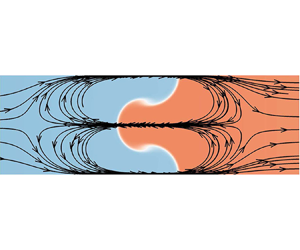Crossref Citations
This article has been cited by the following publications. This list is generated based on data provided by
Crossref.
Mohammadi, Mohammadjavad
Khalifi, Mohammad
Sabet, Nasser
and
Hassanzadeh, Hassan
2023.
Experiments and reduced order modeling of symmetry breaking in Rayleigh-Taylor mixing.
Physical Review Fluids,
Vol. 8,
Issue. 10,
Liu, Changwen
Wu-Wang, Hongzhi
Zhang, Yousheng
and
Xiao, Zuoli
2023.
A decoupled mechanism of interface growth in single-mode hydrodynamic instabilities.
Journal of Fluid Mechanics,
Vol. 964,
Issue. ,
Zhao, Dongxiao
Xiao, Lanlan
Aluie, Hussein
Wei, Ping
and
Lin, Chensen
2023.
Lagrangian investigation of the interface dynamics in single-mode Rayleigh–Taylor instability.
Physics of Fluids,
Vol. 35,
Issue. 10,
ChangWen, LIU
ZuoLi, XIAO
and
YouSheng, ZHANG
2024.
A review of research progresses on potential flow theory of single-mode fluid interfacial instabilities.
SCIENTIA SINICA Physica, Mechanica & Astronomica,
Vol. 54,
Issue. 10,
p.
104702.
Zhou, Ziming
Wang, Zhanming
Huang, Shenghong
and
Xiao, Zuoli
2024.
Numerical prediction on single-mode perturbation growth of Richtmyer–Meshkov instability in a cylindrical geometry.
Physics of Fluids,
Vol. 36,
Issue. 11,
Chen, Feng
Xu, Aiguo
Song, Jiahui
Gan, Yanbiao
Zhang, Yudong
and
Guan, Ning
2024.
Surface tension effects on Rayleigh-Taylor instability in nonideal fluids: A multiple-relaxation-time discrete Boltzmann study.
Science China Physics, Mechanics & Astronomy,
Vol. 67,
Issue. 12,
SONG, Jiaxi
and
PAN, Shucheng
2024.
Numerical investigation of the Richtmyer-Meshkov instability for the vapor-liquid interface with phase change.
SCIENTIA SINICA Physica, Mechanica & Astronomica,
Vol. 54,
Issue. 10,
p.
104710.
Wu-Wang, Hongzhi
Liu, Changwen
and
Xiao, Zuoli
2024.
Parametric effects on Richtmyer–Meshkov instability of a V-shaped gaseous interface within linear stage.
Physics of Fluids,
Vol. 36,
Issue. 2,
Guo, Xu
Cong, Zhouyang
Si, Ting
and
Luo, Xisheng
2024.
On Richtmyer–Meshkov finger collisions in a light fluid layer under reshock conditions.
Journal of Fluid Mechanics,
Vol. 1000,
Issue. ,
Liang, Yu
Alkindi, Ahmed
Alzeyoudi, Khalid
Liu, Lili
Ali, Mohamed
and
Masmoudi, Nader
2024.
Experimental investigation of three-dimensional Rayleigh–Taylor instability of a gaseous interface.
Journal of Fluid Mechanics,
Vol. 994,
Issue. ,
Gao, Xing
Guo, Xu
Zhai, Zhigang
and
Luo, Xisheng
2024.
Interfacial instabilities driven by co-directional rarefaction and shock waves.
Journal of Fluid Mechanics,
Vol. 980,
Issue. ,
Qi, Han
He, Zhi-wei
Xu, Ai-guo
and
Zhang, You-sheng
2024.
The vortex structure and enstrophy of the mixing transition induced by Rayleigh–Taylor instability.
Physics of Fluids,
Vol. 36,
Issue. 11,
Sun, Fang-ping
Song, Yu
Wang, Yu-hui
and
Zhang, You-sheng
2024.
Improved mixing-width model for the linear stage of reshocked Richtmyer–Meshkov turbulence.
Physics of Fluids,
Vol. 36,
Issue. 8,
Mohammadi, Mohammadjavad
Bagherzadeh, Hadi
Nath, Devjyoti
Bin Dahbag, Mabkhot
and
Hassanzadeh, Hassan
2024.
Rayleigh–Taylor mixing in porous media at an extreme viscosity contrast.
Physics of Fluids,
Vol. 36,
Issue. 8,
Xie, Hansong
Qi, Han
Xiao, Mengjuan
Zhang, Yousheng
and
Zhao, Yaomin
2025.
An intermittency based Reynolds-averaged transition model for mixing flows induced by interfacial instabilities.
Journal of Fluid Mechanics,
Vol. 1002,
Issue. ,
Li, Jiaxuan
Chen, Chenren
Zhai, Zhigang
and
Luo, Xisheng
2025.
Asymptotic matching modal model on Richtmyer–Meshkov instability.
Journal of Fluid Mechanics,
Vol. 1002,
Issue. ,
Yan, Zheng
Chen, Zhu
Li, Zhiyuan
Wu, Junfeng
Fan, Zhengfeng
Yu, Changping
Li, Xinliang
and
Wang, Lifeng
2025.
The role of double‐layer vortex rings with the local swirl in the rapid transition to turbulent flows in Richtmyer–Meshkov instability with reshock.
Journal of Fluid Mechanics,
Vol. 1003,
Issue. ,
Sun, Fang-ping
Liu, Chang-wen
Song, Yu
Wang, Yu-hui
and
Zhang, You-sheng
2025.
Spatiotemporal evolution model for compression of mixing width in reshocked Richtmyer-Meshkov Turbulence.
Physica D: Nonlinear Phenomena,
p.
134659.




